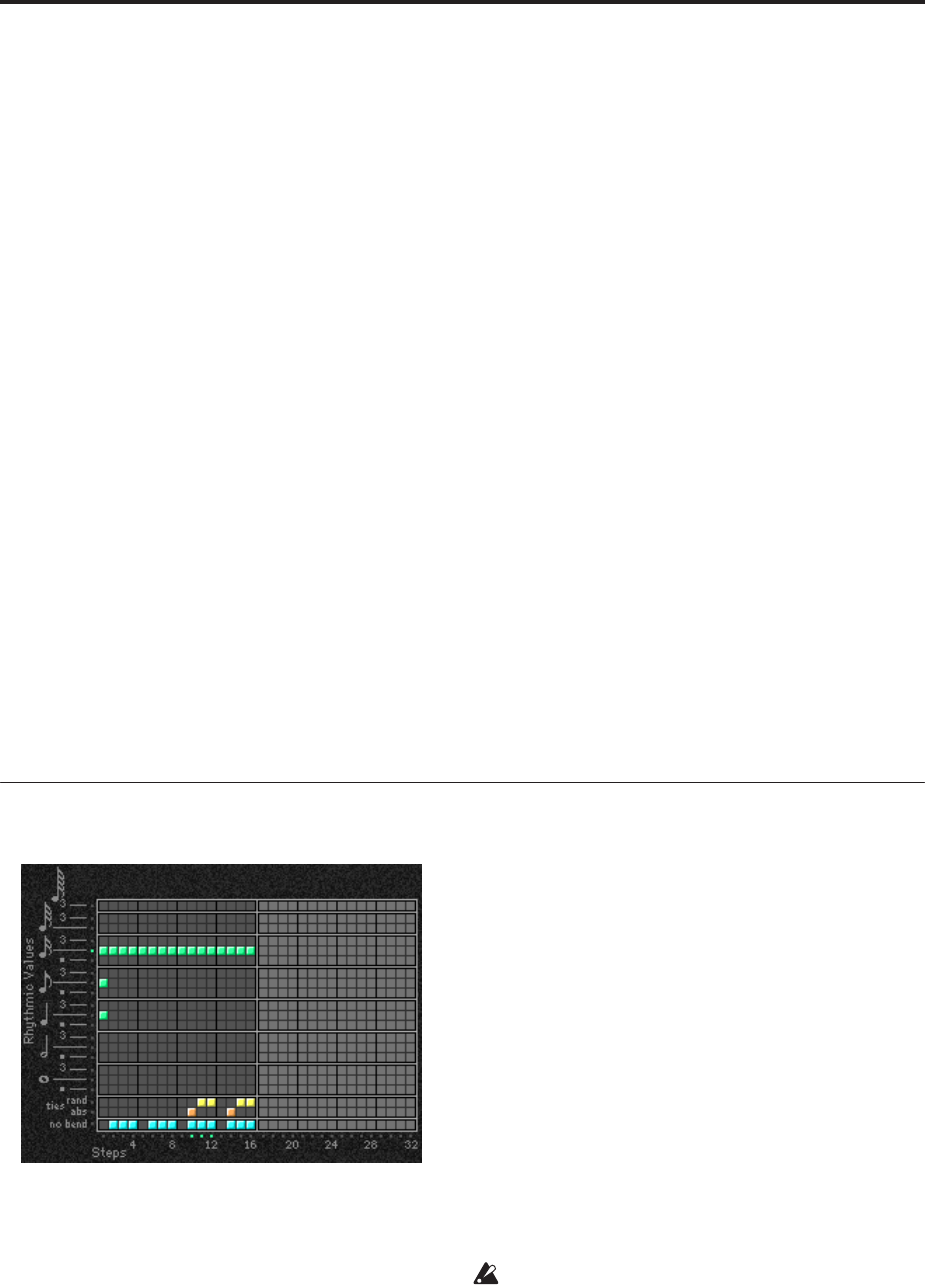
KARMA GE guide
910
Swing Use Multiplier [0…3]
The “Rhythm Multiplier” (explained later on in this
chapter) causes the values in the Rhythm Pattern to be
increased or decreased by a percentage. The “Swing
Use Multiplier” specifies several options for selectively
applying (or not applying) the Rhythm Multiplier(s) to
the “Swing Note Value” also, thereby affecting the
resulting swing feel.
0: Off-do not use Multipliers for Swing
The “Rhythm Multipliers” in each Phase do not have
any affect on the “Swing Note Value”. For example, if
generating 16th notes with a “Rhythm Multiplier” of
100% and “Swing Note Value” set to 1: 16th note, the
resulting 16th notes will be swung with a 16th note
feel. If the “Rhythm Multiplier” is changed to 50%, the
resulting 32nd notes will still be swung with a 16th
note feel. If the “Rhythm Multiplier” is changed to
200%, the resulting 8th notes will also be swung with a
16th note feel, resulting in no perceptible swing (unless
the rhythm is syncopated).
1: Ind-independently use each Phase’s Multiplier
Each Phase’s “Rhythm Multiplier” (☞p.912) will
independently affect swing calculations while
generating rhythms within that Phase. In other words,
the “Swing Note Value” will also have the “Rhythm
Multiplier” applied to it. For example, if generating
16th notes with a “Rhythm Multiplier” of 100% and
“Swing Note Value” set to 1: 16th note, the resulting
16th notes will be swung with a 16th note feel. If the
“Rhythm Multiplier” is changed to 50%, the resulting
32nd notes will be swung with a 32nd note feel. If the
“Rhythm Multiplier” is changed to 200%, the resulting
8th notes will be swung with an 8th note feel. With
this setting, it is possible to swing with different note
values in the two Phases, such as swinging with an 8th
note feel in one phase and swinging with a 16th note
feel in the other.
2: P1-always use Phase1’s Multiplier
Same as 1: Ind above, except that Phase 1’s “Rhythm
Multiplier” will always be used, regardless of which
Phase is currently generating rhythms. This allows the
Rhythm Multiplier to be varied in Phase 1 while
affecting the overall swing settings for the whole effect.
For example, if generating 16th notes in both phases
with both Phase’s “Rhythm Multipliers” set to 100%
and “Swing Note Value” set to 1: 16th note, the
resulting 16th notes will be swung with a 16th note
feel. If Phase 1’s “Rhythm Multiplier” is changed to
200%, the resulting 8th notes in Phase 1 and 16th notes
in Phase 2 will all be swung with an 8th note feel. If
the “Rhythm Multiplier” in Phase 1 is 100% and
changed to 50% in Phase 2, the resulting 16th notes in
Phase 1 and 32nd notes in Phase 2 will all be swung
with a 16th note feel.
3: P2-always use Phase2’s Multiplier
Same as 2: P1 described above, except utilizing Phase
2’s “Rhythm Multiplier.”
Pattern Grid & Associated Parameters
Rhythm Pattern
A Rhythm Pattern controls the rhythm that the notes
are generated with according to a grid of rhythmic
values. It has any number of steps up to 32, with each
step being represented by one column on the grid. The
first column always contains at least one value; unused
columns appear disabled. The top part of the grid
corresponds to 18 different rhythmic values; the
bottom 3 rows are special purpose rows:
[ties: rand] - Random Tie: randomly ties the rhythmic
value in the same column to the previous column’s
rhythmic value. For example, a 16th note in the first
column followed by a 16th note and a random tie in
the 2nd column yields either an 8th note or two 16th
notes. When at least one random tie has been selected,
a weighting curve is available which allows choices to
be slanted towards more ties or less ties, as described
later.
[ties: abs] - Absolute Tie: always ties the rhythmic
value in same column to the previous column’s
rhythmic value. For example, a 16th note in the first
column followed by a 16th note and an absolute tie in
the 2nd column yields an 8th note. The 2 tie rows are
mutually exclusive; only one at a time can be used in
any given column.
[no bend] - No Bend: affects when Automatic Pitch
Bending effects can occur, as set up in the Bend Group.
These effects will normally be triggered with every
single generated note or cluster; by using the “no
bend” row, bends can be prevented from occurring on
various steps of the Rhythm Pattern.
Pattern grids cannot be viewed or edited on the
OASYS.
0: Off 2: P1-Phase1
1: Ind-Independently 3: P2-Phase2


















